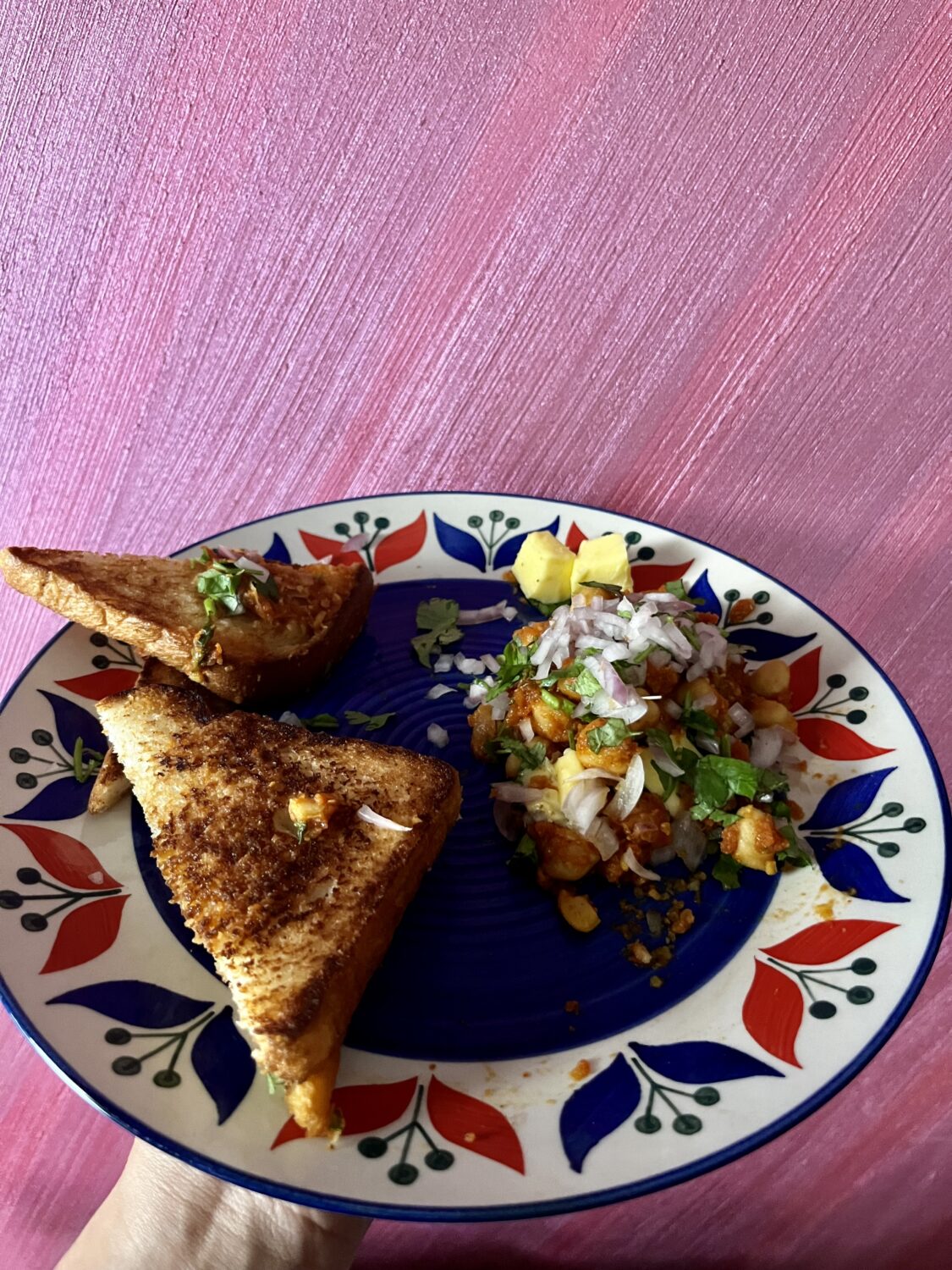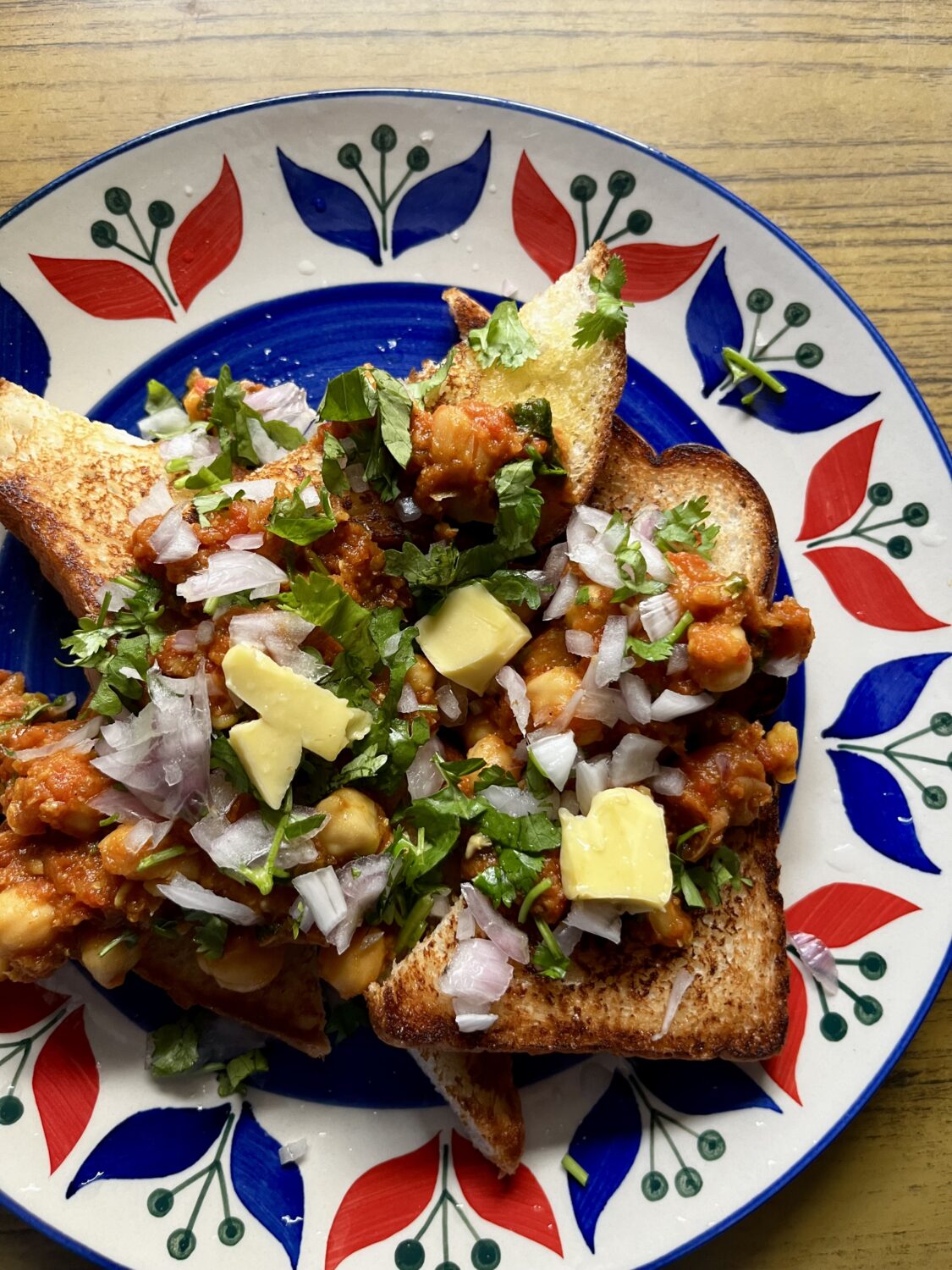Chana Masala on Toast, An Indulgent Supper for Any Time
By Apoorva SripathiSome days call for moderation in eating. Some days call for amends. And there are days, more often than not, when only pure indulgence will do, drawing on reservoirs of pleasure (minus the guilt). For such days, I always make a version of chole (also known as chana masala) or chickpea curry to spoon on top of toasted white bread. Chole, usually paired with bhature or fried bread, has a long history claimed by many states in North India. I don’t want to split hairs here, but the chole bhature empire is vast, having travelled down to the south of India as well. This particular chickpea curry is also a favourite in Pakistan, sometimes with the addition of chicken, and eaten with puris and sooji halwa for breakfast. Of course, there is no doubt why.
The curry is a mainstay in the subcontinent’s vast array of street food, the samosa chaat in particular, a popular iteration featuring crispy samosas smashed into pieces, flooded with chickpea curry, and garnished with chopped onion, sev, coriander, and chutneys. All these years, I foolishly thought that my recipe was a modest take on the samosa chaat, replacing the samosa with white bread. It was only a few years back that I came across a recipe for ‘chola dabal’, a street snack in Sindh, Pakistan, that was popular during the pre-Partition era, and later migrated to wherever Sindhis settled down in the subcontinent, post-Partition. The recipe was featured in Sapna Ajwani’s Sindh: Recipes and Stories from a Forgotten Land, which I had the privilege of editing.
While chola dabal calls for soft rolls or pav breads, I use thick, fluffy slices of white bread. You can use any bread you want, but thick white slices make all the difference – the white bread’s sweetness offsets the curry’s spiciness and the thick slices, toasted with a generous amount of butter, uphold the runny curry.
Like all recipes, this too is open to innovation: skip the white bread and have it with chapati or roti; omit the bread and eat it with rice; dollop some yoghurt on top for a cool contrast; or grate some cheese on the whole thing and grill till it’s brown and delightfully oozing. There is simply no wrong way to eat this.

Serves 4
Ingredients
2 tins of chickpeas/about 450-500g (250g if using dried, soaked overnight)
3 tablespoons vegetable oil
2 tablespoons ghee
2 teaspoon cumin seeds
4 shallots or 2 small red onions, finely chopped or grated
2-inch piece ginger, roughly chopped
3 garlic cloves, crushed
5-6 medium ripe tomatoes, finely chopped or whizzed in a blender
2 to 3 green chillies, slit down the middle
1 teaspoon turmeric powder
3 teaspoons cumin powder
3 teaspoons coriander powder
1 teaspoon chilli powder + 1 Kashmiri chilli powder (for the colour)
1.5 teaspoons garam masala
1 teaspoon amchur powder (alternatively, you could use a scant teaspoon of pomegranate molasses)
3 to 4 slices of thick, white bread per person
Butter for toasting
Salt to taste
White granulated sugar (optional)
Garnish
1 teaspoon chaat masala
10-15g fresh coriander leaves, finely chopped
1 red onion, finely chopped
3 lemons, cut into quarters
Method
If you’re cooking the chickpeas from dry, soak overnight (about eight hours) in enough water to cover. Next morning, drain and rinse the chickpeas and set aside. If you’re using tinned chickpeas, drain and rinse and set aside.
In a Dutch oven/large pot/pressure cooker set over medium-high heat, add 2 tablespoons of oil, a tablespoon of ghee, and cumin seeds and fry till fragrant. Add the onions and turn the heat down, sauteeing until they go from lightly purple to translucent. Add the ginger and garlic and saute until aromatic. Then add the chopped (or blended) tomatoes and stir. As the mixture reduces, it tends to catch the bottom of the cooker/pot, so add the remaining oil and keep stirring. Add in the powders: turmeric, cumin, coriander, and chilli and mix. Saute the mixture well until the liquid has reduced, it becomes a soft pulp and has changed colour from a bright to a dull red. The more it cooks, the more there is oil on the sides of this mixture. Add the green chillies and stir again.

Now add the chickpeas, about half a tablespoon of salt, and enough water to just cover the chickpeas. If you’re using a pressure cooker, cook for about 8 to 10 whistles, or 15 minutes in total. If cooking in a Dutch oven/pot, simmer till the chickpeas are tender and holding their shape. If you’re using tinned chickpeas, add about a cup of water and mix. Simmer for a few minutes, mash some chickpeas with the back of a ladle or a spoon so the gravy can thicken. It shouldn’t be too runny but also not too thick.
Add amchur and garam masala and the remaining ghee and stir. Switch the stove off and taste for salt. If you find it’s too spicy, sour, or salty, add in a teaspoon of sugar and mix.
To serve, toast two slices of bread at a time on a frying pan with butter till golden brown. Cut into triangles, place on a plate, spoon the chickpea curry on top, and garnish with chopped coriander and onion, and a sprinkle of chaat masala. Serve with a wedge or two of lemon and some butter on top if you’re feeling extravagant.
Leftovers make for a great sandwich filling! Simply reheat the curry till dry and mash some of the chickpeas. When you have a rough paste, take it off the stove and let it cool. Spread this paste on a slice of bread, top with grated cheese, and make a grilled cheese.
Apoorva Sripathi is a writer and editor from Chennai, and the co-founder of the independent magazine CHEESE. She also writes shelf offering, a food and culture newsletter. You can find all her work at apoorvasripathi.com. Photography by Apoorva Sripathi.